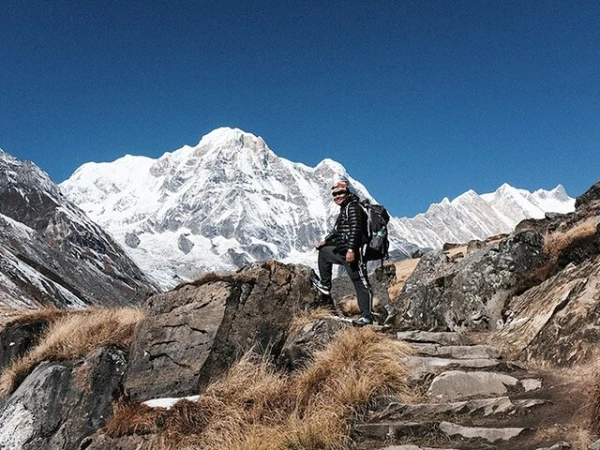Vous rêvez d’un trek combinant aventure, nature et sérénité ? Le Mardi Himal Trek est l’un des joyaux cachés du Népal. Situé dans la célèbre région de l’Annapurna, ce trek offre des panoramas spectaculaires sur les sommets emblématiques tels que l’Annapurna, le Dhaulagiri et le Machapuchhare (Fishtail).
Le grand avantage du Mardi Himal Trek réside dans son calme et son authenticité, loin des sentiers bondés comme celui de l’Annapurna Base Camp.
Accessible à tous les niveaux, ce trek est idéal pour les débutants ou les randonneurs modérés, souhaitant découvrir la beauté himalayenne sans affronter une expédition trop longue ou difficile. Vous traverserez des forêts luxuriantes, des villages chaleureux et des paysages époustouflants, tout en vivant une véritable immersion culturelle et naturelle.
En seulement 7 jours, vivez une aventure inoubliable au cœur des montagnes népalaises.
Permis nécessaires pour le Trek du Mardi Himal
Pour randonner sur le sentier du Mardi Himal, deux permis sont obligatoires (sauf pour les citoyens népalais) :
Annapurna Conservation Area Permit (ACAP) — 3 000 NPR (≈ 25 USD)
Nécessaire pour entrer dans la zone protégée de l’Annapurna.
Disponible à Katmandou ou à Pokhara (auprès du Nepal Tourism Board) ou aux points d’entrée du trek.
Trekkers’ Information Management System (TIMS) Card — 2 000 NPR (≈ 18–20 USD)
Permet de suivre les randonneurs et d’assurer leur sécurité.
Disponible à Katmandou (TAAN Office) ou à Pokhara.
Gratuit pour les enfants de moins de 10 ans.
Documents requis
Passeport valide (au moins 6 mois) + photocopies
2 à 4 photos d’identité récentes
Itinéraire prévu, contact d’urgence et assurance voyage
Points forts du Trek du Mardi Himal
Vues panoramiques sur les Annapurna, Dhaulagiri et Machapuchhare au lever et au coucher du soleil.
Traversée de forêts de rhododendrons colorés et d’une biodiversité unique.
Dégustation de plats népalais typiques : Dal Bhat, Momo, Thukpa…
Rencontre avec les villages traditionnels Gurung et découverte des monastères bouddhistes.
Trek paisible, loin de la foule, avec des panoramas intacts et authentiques.
Principales étapes du Trek du Mardi Himal
Pokhara (820 m)
Ville de départ du trek, Pokhara est une perle du Népal. Bordée par le lac Phewa, elle offre une atmosphère paisible et des vues splendides sur la chaîne des Annapurna. C’est le lieu idéal pour se préparer avant l’aventure.
Phedi (1 130 m)
Le trek débute réellement à Phedi. Une montée progressive permet de s’acclimater tout en profitant de magnifiques paysages verdoyants.
Australian Camp (2 060 m)
Premier grand arrêt du trek, l’Australian Camp offre une vue panoramique sur les Annapurna et le Machapuchhare. C’est un lieu parfait pour observer le lever et le coucher du soleil sur l’Himalaya.
Forest Camp (2 540 m)
Comme son nom l’indique, ce camp est niché au cœur de la forêt. Entouré de rhododendrons et de chênes, il offre un cadre paisible et frais. Avec un peu de chance, vous pourrez apercevoir des singes ou des oiseaux rares.
Low Camp (3 050 m)
Situé au-dessus de la forêt dense, le Low Camp offre déjà de magnifiques vues dégagées sur les sommets. C’est une étape clé pour s’acclimater avant l’ascension vers le High Camp.
High Camp (3 580 m)
Le High Camp marque la dernière étape avant le camp de base du Mardi Himal. La montée est exigeante, mais la vue à 360° sur l’Annapurna Sud et le Machapuchhare récompense tous les efforts. Ici, le sentiment d’accomplissement est incomparable.
Siding (1 700 m)
Dernière étape du trek, Siding est un village typiquement népalais. Vous y découvrirez la vie rurale, l’hospitalité des habitants et profiterez d’un dernier moment de détente avant de retourner à Pokhara.
Meilleures saisons pour le Trek du Mardi Himal
Printemps (mars à avril)
C’est la meilleure saison pour le trek : les forêts de rhododendrons sont en fleurs, le climat est doux et les vues sont dégagées.Automne (octobre à novembre)
Températures idéales, journées claires, ambiance festive avec les grandes célébrations de Dashain et Tihar.
Saisons à éviter
La mousson (juin à août) rend les sentiers glissants et augmente le risque de glissements de terrain. Les vues sont souvent obstruées par les nuages.
Cependant, les treks hors saison offrent des prix plus bas et moins d’affluence.
Pourquoi choisir Excited Travels pour le Trek du Mardi Himal ?
Équipe professionnelle et expérimentée : guides certifiés, porteurs assurés, assistance 24/7.
Organisation complète : de l’arrivée à Katmandou jusqu’au retour, tout est pris en charge.
Itinéraire flexible et personnalisé selon vos envies et votre niveau.
Garantie “sans souci” : nous nous occupons des permis, transports, hébergements et repas.
“Chez Excited Travels, nous restons à vos côtés à chaque étape — de votre arrivée à votre retour.
Nous sommes là pour vous !”
Réservez votre Trek du Mardi Himal dès aujourd’hui !
Laissez Excited Travels transformer votre rêve d’aventure en réalité.
Contactez-nous dès maintenant pour planifier votre Trek du Mardi Himal ou d’autres randonnées comme l’Everest Base Camp Trek, le Manaslu Circuit ou l’Annapurna Base Camp.
Profitez du meilleur rapport qualité-prix et d’une expérience inoubliable au cœur du Népal.

.webp)
.webp)




